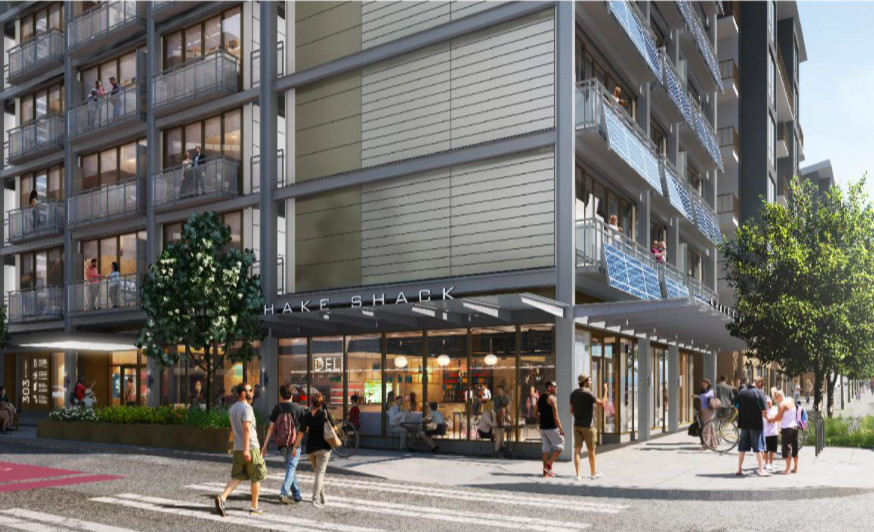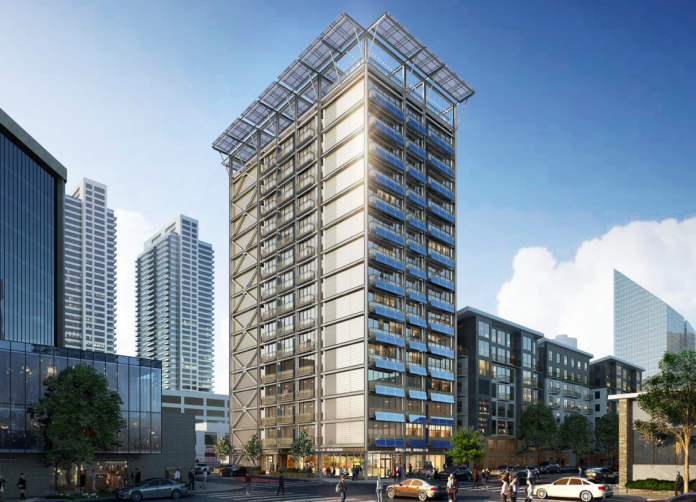
On a humble lot in Belltown, a remarkable building is underway. While 303 Battery may never raise the same level of international buzz as the 1960’s era Space Needle, it is posed to quietly revolutionize the future of buildings, not just in Seattle, but potentially around the world.
At 15 stories, 303 Battery is not just the world’s first net zero energy highrise apartment building. The development also pushes the boundaries of smart building technology, affordability, and sped of construction thanks to a proprietary building technology system created by Sustainable Living Innovations (SLI), a locally grown company that evolved out of Seattle-based architectural firm CollinsWoerman.
Inspired to tackle both affordability and environmental sustainability in the built environment, founders Arlan Collins and Mark Woerman used the uncertainty created by the Great Recession to embark on exploring how technological advancement could create better buildings. The result was the creation of SLI, whose modular buildings are assembled from 44 different pre-fabricated floor, wall, and ceiling panels placed into a steel exoskeleton. If you were to crack open one of these panels, inside you would find electrical wiring, plumbing, and mechanical equipment, including fiber optic cables.
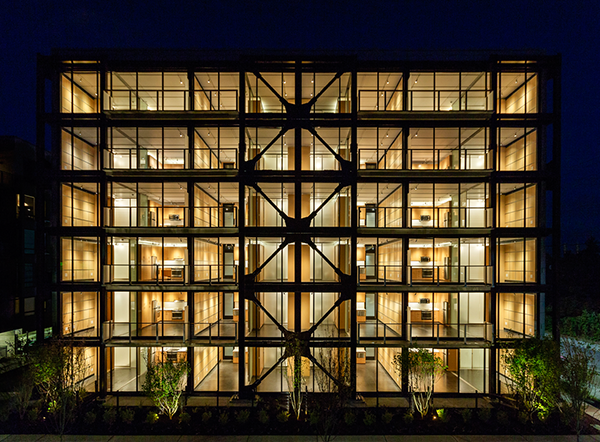
Together the prefabricated and modular construction system allows for a completely smart tech enabled building that can be built primarily offsite in a factory where changes in the weather never slow down the progress of construction. According to SLI, this method of construction effectively eliminates construction waste, and provides steadier employment for construction sector workers, who may find themselves out of work in the region’s colder, wetter months.
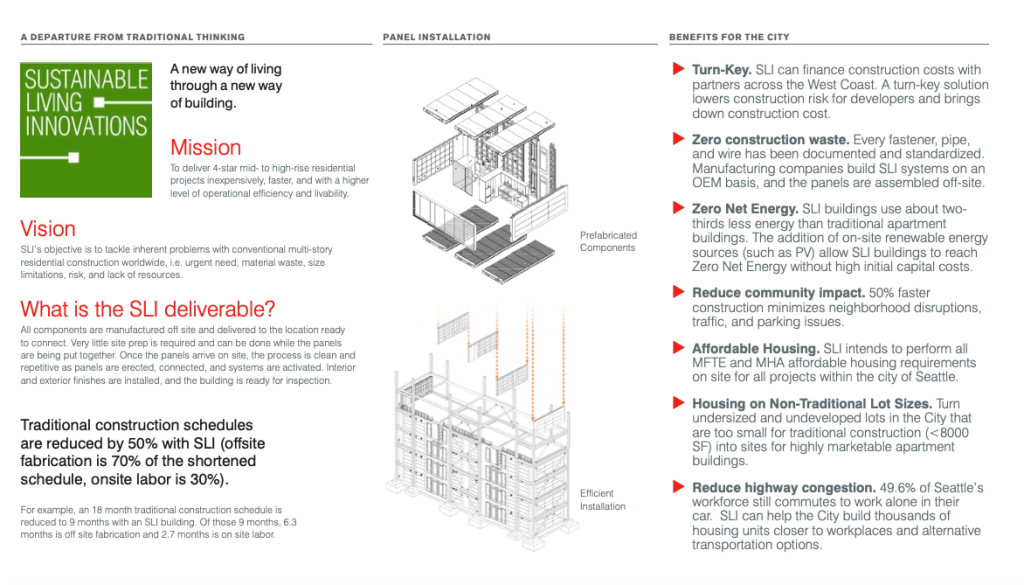
Do Pre-Fab Buildings Live Up to the Hype?
In 2020, The Urbanist‘s Shawn Kuo wrote “The Potential and Pitfalls of Prefabricated Buildings,” an article that assesses how SLI claims stand up to the literature. Kuo said the literature supports the idea that pre-fabricated buildings generate less waste, reduce construction times, minimize noise impact on surrounding communities, and lead to improved conditions for workers, most notably in the area of worker safety.
However, the environmental picture is more complex, mostly because not enough time has elapsed to compare the lifecycle of the new generation of pre-fabrication buildings, like those built by SLI, against that of their conventional counterparts. Collins said SLI’s buildings have been designed for durability. The buildings are non-combustible, and the steel exoskeleton is equipped to confront both earthquakes and high winds. Together these features, along with the smart tech building monitoring systems, should mean that the buildings will have a long lifespan.
In theory, at their end of life components in pre-fabricated steel frame buildings should be more readily recyclable than timber or concrete, but it is difficult to know what the level of demand will be for the raw materials that would result from future recycling processes in the future. Shipping is another area where the environmental picture becomes murky. Given that its panels are manufactured in Knoxville, Tennessee, and Calgary, Alberta before being assembled in its Tacoma factory, SLI’s buildings may have a larger shipping energy footprint than similar buildings. As a side note, none of its shops appear to be unionized.
However, Kuo also found that based on a 50-year timespan, materials shipping constitutes only 1% of building energy expenditure. Instead, energy use over time is by far the most important factor to consider when assessing environmental impact, and in this regard 303 Battery has a definite edge. An article in the Journal of Green Building found that a striking 83% of a building’s energy use occurs during the building use phase when analyzed on a 50-year timespan. Thus, if 303 Battery maintains its net zero energy status over its life cycle, its environmental impact will be significantly less than conventional counterparts.
After the first panels are installed around Labor Day of this year, construction is anticipated to take an additional four to five months, which is very rapid for a building of its size. When completed, the building will feature 112 units, 27 of which designated as affordable through the City of Seattle’s Multi Family Tax Exemption (MFTE) program. No parking has been planned for the site, and if the renderings of a Shake Shack on ground level prove to be accurate, future tenants can indulge in a quick bite to eat without having to leave the premises.
A Warm Reception From Local Elected Officials
Local officials are pretty much doing backflips to celebrate the fact that SLI’s building technology has emerged in Washington State. Both Seattle Mayor Jenny Durkan and King County Executive Dow Constantine came out for 303 Battery’s groundbreaking ceremony, and SLI has already been awarded contracts for several major city-funded affordable and mixed-income developments. Even the governor has taken notice to SLI’s work, calling 303 Battery, a “miracle of sustainability.”
“SLI is showing that we can both address climate change and build up our economy,” said Governor Jay Inslee in a press release. “This revolutionary approach to building is a homegrown innovation success story that will change the built environment across the nation.”
Collins attributes SLI’s success in gaining these contracts to the buildings “downward sloping cost curve” resulting from lower energy and water consumption. “We are competitive because we are actually changing how buildings are made and we are changing what is in the buildings in terms of technology and how the building operates,” Collins said.
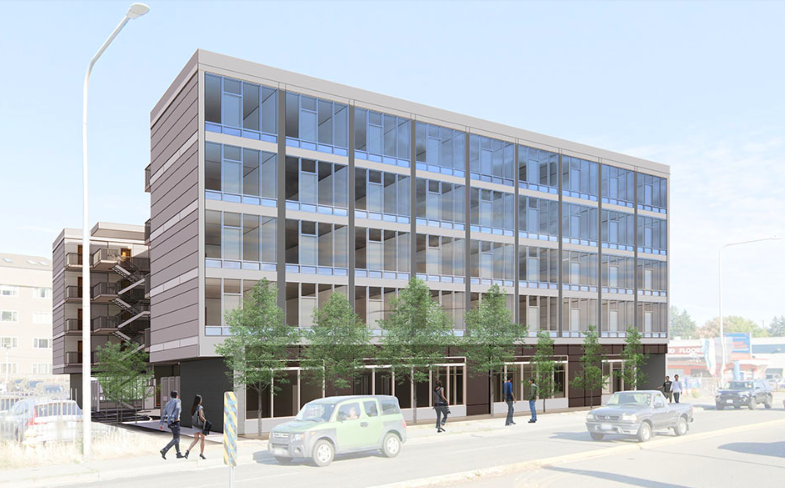
In addition to 303 Dexter, multifamily buildings in the works by SLI include:
• Sacred Medicine House: In partnership with Chief Seattle Club and the City of Seattle’s Office of Housing, SLI will build a 120-unit permanent supportive housing project.
• DESC Greenlake: In partnership with the Downtown Emergency Service Center and the City of Seattle’s Office of Housing, SLI will build a 124-unit permanent supportive housing project.
• 615 Dexter: SLI will build an 18-story tower of 414 units, 219 of which will be restricted as affordable. The 615 Dexter project is part of the City of Seattle’s Mercer Mega-block redevelopment effort.
• Yesler Terrace: After winning a competitive bid process with the Seattle Housing Authority, SLI will build a 22-story tower featuring 376 units, with 86 units affordable.
• 1800 Terry: A 40-story, 428-unit luxury apartment tower in Downtown Seattle recently completed the City’s Design Review Board process and is awaiting final entitlements.
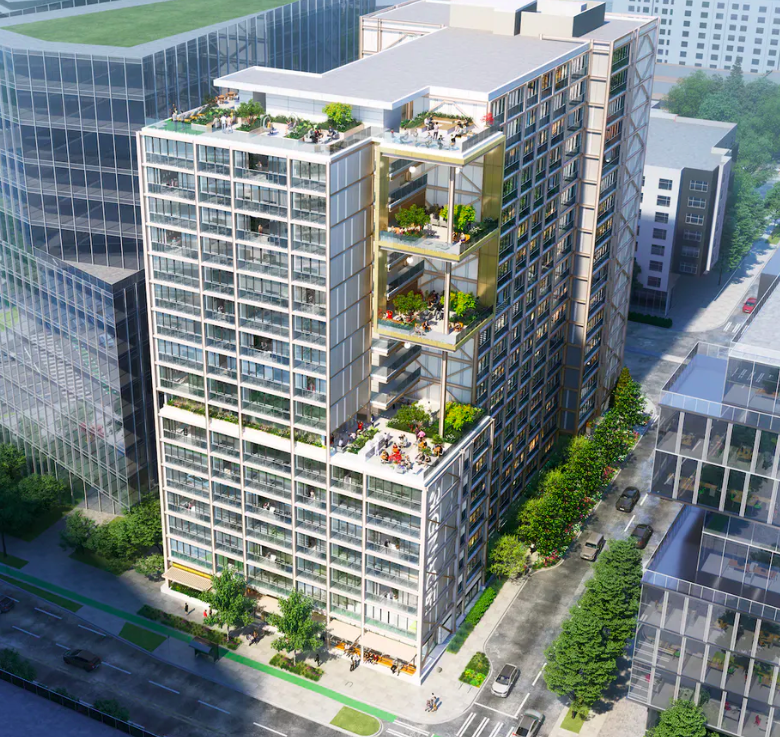
How Will 303 Battery Attain Net Zero Energy Use?
The International Living Future Institute (ILFI), based out of Seattle’s super green Bullitt Center, has designated 303 Battery as a net zero energy building. The organization has also awarded 303 Battery three petal awards: energy, place, and beauty.
So how has 303 Battery earned these distinctions? Operating solely on electricity, the building will be powered by more than 600 solar panels distributed across the building’s roof, exterior walls, and balconies. Onsite battery storage will be used to cover nighttime power use and power outages, while an ultra efficient air conditioning system will use approximately 4% of the energy of a traditional system, SLI said.
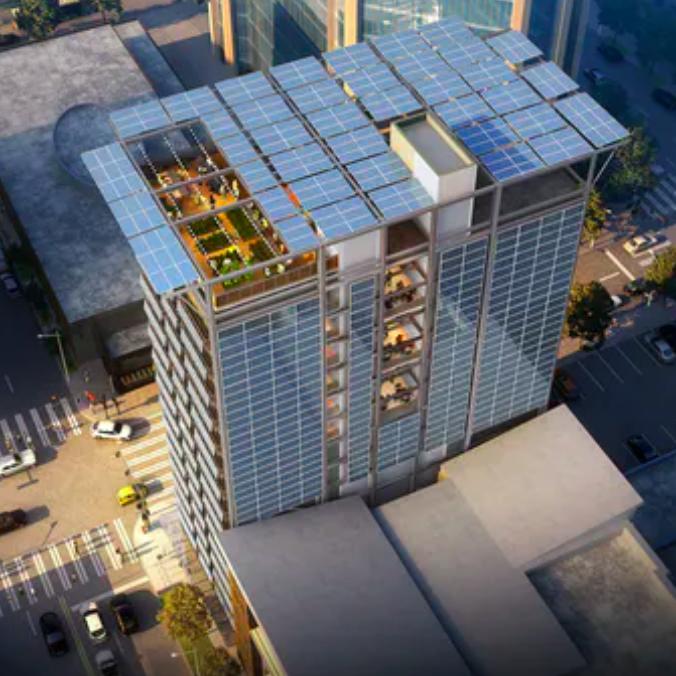
Of course, heat is typically of more concern in chilly Seattle, but 303 Battery has that covered as well. Underfloor radiant heat in units will provide an efficient source of warmth, while 80% of heat from showers will be trapped and recycled within the building. The building also additionally nifty energy saving features like regenerative gear elevators and daylight sensors that will reduce power use throughout the building. As a whole, 303 Battery has been designed to use only the half the energy of an apartment building of its size.
People who geek out on artificial intelligence will be interested to learn that fiber optic cables will be integrated through the building with the goal of enhancing tenant’s living experience and optimizing the buildings performance. This technology will provide 24-hour monitoring of the buildings environment at the apartment unit level, analyzing trends in heating, cooling, energy, and water. Each unit will be equipped with a smart thermostat, remotely controlled lights and blinds, and motorized smart locks. Both building tenants and management will have access to an Integrated SmartLiving app that provides insights into how to conserve energy and water.
Other notable sustainable features include a grey water system and space for urban agriculture for future tenants with green thumbs. The building site was identified as contaminated, so SLI completed the state required process for site decontamination over a six month period prior to groundbreaking.
Light-filled, Beautiful Spaces to Live In
When I chatted with Collins about the project, I was surprised to learn that of all 303 Battery’s unique features, he was most proud of the interior design of the living units. “We started out trying to build a better space to live. Our building was designed from the inside out. Every space in the apartment is filled with natural light including the kitchen and bathroom,” said Collins, who was enthusiastic about the presence of a sliding glass wall in each unit that opens, transforming each unit into an indoor/outdoor living space.
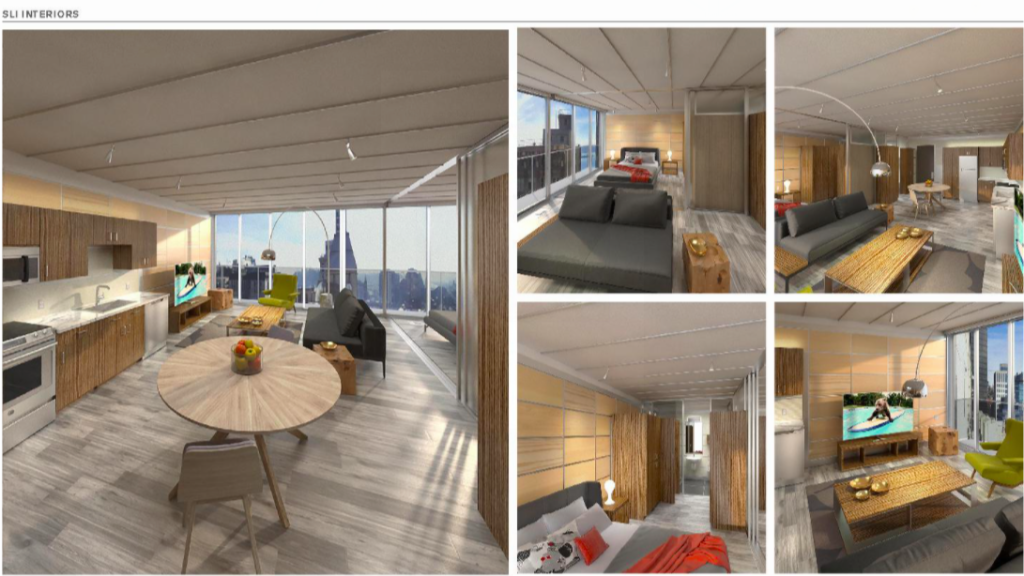
“We did that because that we thought it was really important to create a better place to live in the urban environment,” said Collins, who went on to emphasize the importance of creating inspiring places to live in cities in order to “lower the burden of all of us living on Mother Earth.”
Personally, I found the concept of the sliding glass wall appealing, although as the owner of a cat who delights in chasing flies near windowsills, the concept of an indoor/outdoor living space so high above the ground inspires a bit of dread in me as well. People who are not inclined toward contemporary aesthetics may also find the interiors a bit too minimalist for their liking. For people are interested viewing SLI’s designs themselves, the company has a showroom in Seattle which should be reopen for people to tour in the future.
Collins also shared that he is proud of the jobs that SLI has created in their factory in Tacoma. The company currently has 30 employees and has made it a point to recruit people who have historically faced employment barriers. “At the same time we are excited about the fact that we are able to provide affordable housing, we have also worked hard to search out folks who don’t have as many opportunities to work in our factories,” Collins said.
SLI’s workforce includes people who have experienced homelessness, formerly incarcerated people on work release, members of the disability community, and veterans, Collins said, adding they are also committed to supporting people of color and gender diversity among their employees. Construction is a highly unionized sector, so SLI being a non-union shop could eventually become an issue for employees and perhaps some progressive developers as well.
“We are committed to helping other people as we grow our business and that includes everyone who is in the ecosystem of our company,” Collins said. “We want everyone’s life to be better.”
Natalie Bicknell Argerious (she/her) is a reporter and podcast host at The Urbanist. She previously served as managing editor. A passionate urban explorer since childhood, she loves learning how to make cities more inclusive, vibrant, and environmentally resilient. You can often find her wandering around Seattle's Central District and Capitol Hill with her dogs and cat. Email her at natalie [at] theurbanist [dot] org.

